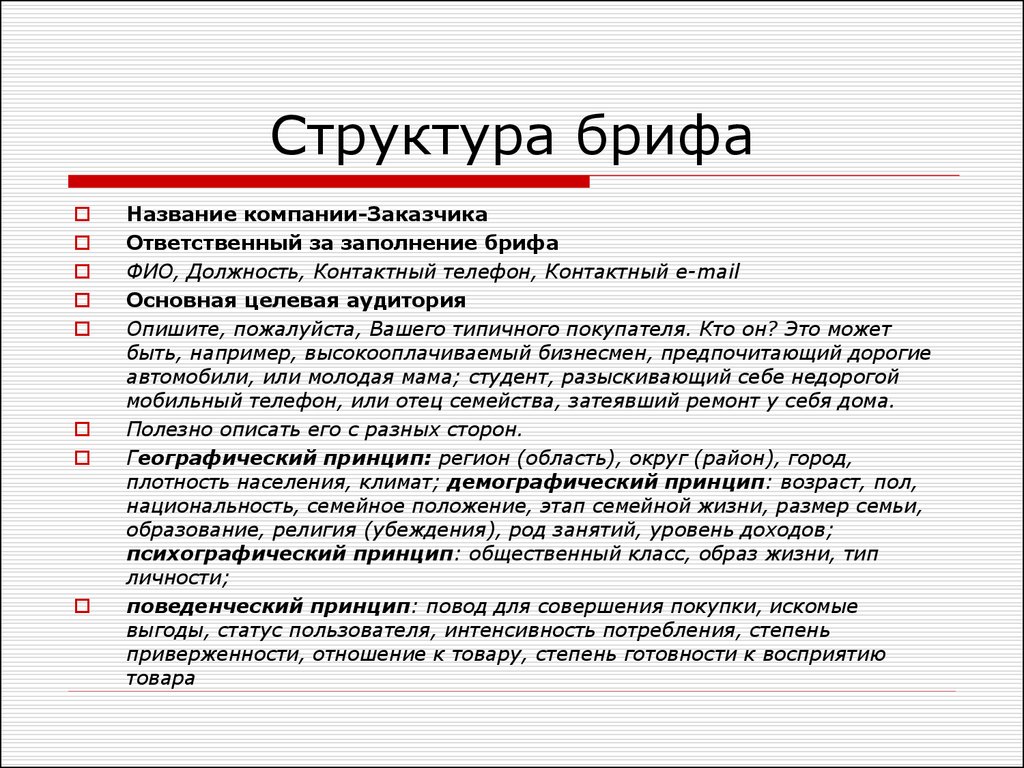A brief is an essential element in the digital world. Without it, marketers, developers, and SMM specialists are in the dark about the client’s tasks. We dove deep into this topic and invited experts to share their valuable advice and provide templates to help create effective briefs.
Understanding the brief and its purpose
Бриф можно сравнить с «резюме» проекта. Это анкета, которая знакомит исполнителя с клиентом и поставленными перед ним задачами. В нем содержится основная информация о проекте, включая его суть, сроки реализации и ожидания заказчика. Кроме того, в брифе часто присутствуют общие вопросы о компании-заказчике, что помогает исполнителю глубже понять бизнес клиента.

The value of a brief
Брифинг часто является важной частью воронки продаж, позволяя сторонам оценить, подходят ли они друг другу. Без брифинга невозможно правильно оценить стоимость проекта. Он также выступает важной «страховкой» для исполнителя, определяя требования и ожидания к проекту.
Brief Contents: Key Points
Company Information: General questions about the client company help to get an idea of its activities.
Product description and its USP: Disclosure of the main characteristics of the product and its unique offering.
Brand information: Information about the corporate style, slogans and philosophy of the company.
Project goals and objectives: Clear definition of the goals that the client wants to achieve.
Budget Constraints: Clarifying the financial framework for the project.
Target Audience: A detailed description of the target audience and its characteristics.
Examples of work: Illustrations or references to work that inspires the client.
Organizational aspects: Establishing deadlines, communication processes and responsibilities of the parties.
Technical requirements: Specifications for the use of programs and tools.
Additional wishes and comments: Any additional information or requirements that may be useful in completing the project.
Brief – The Key to Successful Cooperation
A brief is not just a formality, but a tool that ensures successful cooperation and effective project implementation. A detailed and informative brief helps avoid misunderstandings and mistakes at the task execution stage, and also promotes a deeper understanding of the client’s goals and requirements.
Solving the Riddle of Customer Objections: How to Use Them to Your Business' Advantage
Клиентские возражения — это точка, на которую часто обращают внимание подрядчики, работающие в сфере рекламы, маркетинга или продаж. Они включают в себя причины, почему клиенты не готовы приобрести продукт или услугу. Примеры таких возражений включают «у вас высокие цены», «я не знаком с вашей компанией», «у меня уже есть поставщик».
These objections can be varied and reflect different aspects of the customer's decision to purchase a product or service. For example, they can take the form of comments about the high price, insufficient knowledge about the company or an existing supplier.
Using customer objections to your advantage requires a strategic approach and understanding their root causes. Instead of viewing objections as a roadblock, they can be viewed as an opportunity to deepen your understanding of your customer’s needs and improve your product or service offering.
For example, an objection about a high price may become an incentive for a supplier to offer the customer more favorable conditions or to demonstrate the benefits of the product that compensate for its cost. An objection about insufficient knowledge about the company may become a reason for conducting additional information campaigns or providing the customer with more detailed information about the brand and its benefits.
Thus, the ability to effectively respond to customer objections and use them to your advantage can lead to improved customer relationships, increased trust, and increased sales.

Taking Competitors into Account
An important part of the brief is information about competitors. This section describes who they are and how their products, services or services differ from those offered by the client. This allows you to understand the strengths and weaknesses of competitors, and sometimes their promotion budget. This information can be very useful in solving problems. You can also find out what phrases to avoid in communication so as not to create associations with competitors.
Examples of work that the client likes
Examples of work that the client likes are a key element in the process of creating a brief and setting the client’s expectations. Evaluating work that evokes positive emotions in the client is a highly subjective process, especially when it comes to design, websites or texts.
Each client employee has their own taste, preferences and creative vision, which makes this process even more individualized and complex. Therefore, during the briefing and gathering information for the brief, it is important to obtain references and samples of work from the person who will approve the final result of the project.
These examples of work that the client likes can be either internal developments of the company or external projects that arouse interest or admiration. They help the contractor better understand the client's preferences and expectations, as well as create a more accurate idea of what the final result of the project should be.
Obtaining references from the client's key stakeholders reduces the risk of misunderstandings and dissatisfaction during the project. It also helps improve communication between the contractor and the client, which is an important aspect of successful project completion.
Organizational aspects
It is necessary to clarify all organizational issues, such as deadlines, stages of work and who needs to approve the result. Sometimes it is important to clarify in which programs the projects will be submitted.
There are no strict rules for writing a brief. Questions can be asked in any logical sequence, and answers can be written down in a program convenient for you.
Expert Advice: How to Conduct a Client Briefing
Having talked to the heads of foreign and Russian digital agencies, we found out the following:
Who should fill out the brief: the client themselves or the contractor based on the customer’s words?
It is important to interview the client yourself rather than provide them with a form to fill out. This will allow you to better understand their needs and desires, as well as build a trusting relationship.
At what stage of the deal should you ask to fill out a brief?
Basic questions can be included in the application form on the company's website. At the first personal meeting, a more detailed brief should be filled out in order to start collecting information about the client as soon as possible and to show readiness to get involved in the work.
Towards the Truth about Competitors and Briefs: Keys to Communication with Clients
— How to get information about the client’s competitors?
— It is important not only to take the client's word for it, but also to conduct your own research. Sometimes the information provided by the client about his competitors may not be entirely accurate or even distorted.
It also happens that a brand with similar positioning is not a competitor in search results. Therefore, we take two steps: first, we conduct a briefing with the client, and then we independently research the market, studying competitors and checking the facts and figures provided.
— Should the results of the briefing be agreed upon with the client? What is the best way to organize this part of the communication?
— It is essential to summarize the meeting or call. It is important to go over all the points and outline the next steps. Then it is necessary to clarify who exactly is making the next move and agree on the date of the next meeting. These are the basics of any successful business conversation. Failure to do these steps can result in the loss of a client.
— What is the best way to record answers to briefing questions during a face-to-face or online meeting?
— Главное — делать это письменно. Можно использовать блокнот, записи на телефоне или таблицы Excel — важно, чтобы информация была зафиксирована. Это необходимо, чтобы спустя время вы могли пересмотреть ответы и поделиться информацией с коллегами для дальнейшей работы.
After the meeting, you should send the completed brief to the client for approval. If you feel that something was misunderstood, the client should be given the opportunity to correct it.
— How to design a brief that the client fills out himself?
You can choose any format that is convenient for you. Most often, tables in Word or Excel are used. Google forms are also convenient, since they are easier to fill out, as well as the Tilda constructor, which allows you to create visually attractive and individualized forms.
— What is the difference between a brief and a technical assignment?
— Бриф — это первое знакомство, на котором выясняются цели клиента и ожидаемые результаты. Здесь могут быть указаны предпочтительные площадки и инструменты, но это не обязательно.
Техническое задание — это следующий этап, на котором формируются конкретные цели, измеримые результаты, используемые инструменты и другие параметры для точного выполнения задачи.
Иногда бриф может включать в себя элементы технического задания, особенно если это касается конкретных параметров. Однако в большинстве случаев бриф — это более общее описание задачи, а техническое задание — более конкретный план действий.
— Is it necessary to formalize the brief legally? How to do it correctly?
— Если бриф — это техническое задание, на основе которого выполняется работа или услуга, его можно включить в пакет документов. Однако это не всегда требуется: иногда достаточно просто описать услугу и согласовать метод измерения результатов.
For example, if you write a hundred texts for social networks per month, it may be useful to create a guide that contains the basic rules for writing them. And the number of texts can be fixed in the contract with the client.
— Are there any limits on the number of questions in a brief? How long should an oral briefing last?
— There are no strict limits on the number of questions. You can include in the brief both mandatory (marked with an asterisk *) questions and optional ones that the client can answer if they wish. However, you should not overload the client with too many questions if a dozen are enough to complete the work.
It is better not to conduct an interview longer than an hour, as it can reduce concentration. At the meeting, you can get answers to the main questions, and the rest can be asked to the client in writing.








